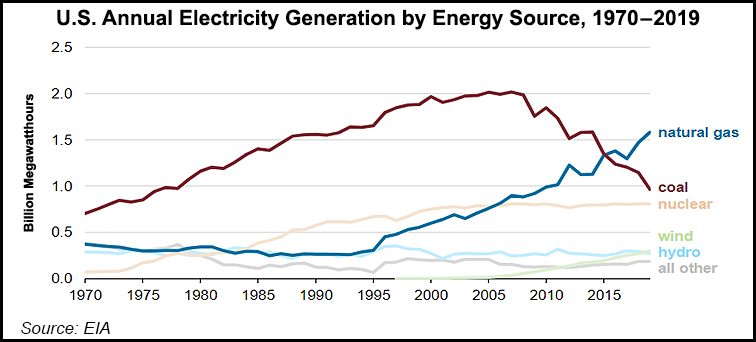NGI The Weekly Gas Market Report | Markets | NGI All News Access
U.S. Coal-Fired Power at Lowest Levels in 42 Years as Natural Gas Reaches New Records
The U.S. coal-fired generating fleet saw its output levels decline to nearly 966,000 GWh in 2019, the lowest level since 1976, marking the largest percentage decrease in history, the Energy Information Administration (EIA) said Monday.

Furthermore, average delivered prices for coal at power plants declined, as the cost of coal through 2015 averaged $2.25/MMBtu. The rate in late 2019 fell to less than $2.00.
The coal fleet’s rate of utilization also saw a significant decrease in 2019 to 48%, versus 67% capacity in 2010. While demand for electricity may have been the culprit for the decline, the EIA noted the increased output from natural gas-fired plants and wind turbines.
Gas-fired generation set a new record last year of 1.6 million GWh, an 8% increase from 2018. Gas combined-cycle turbine (CCGT) plants ran at 57% of capacity, almost 10% higher than the coal utilization rate. Meanwhile, electricity generated from wind turbines increased 10% from 2018, which also marked a new record of more than 300,000 GWh last year.
The EIA attributed the biggest influencer of the decreasing coal-fired generation to the increased availability of low-priced natural gas. In 2011, coal-fired capacity peaked at 318 GW, yet because of the rapid rise in the development of Lower 48 gas reserves, natural gas surpassed coal as the most-produced domestic fuel the same year, according to NGI. Since then coal has been decreasing, and it had 229 GW of generating capacity in 2019.
CCGT plants have reduced the amount of time a coal plant is needed to produce power. The result is lower average coal plant utilization rates, which in turn has pushed some coal plants to early retirement.
According to EIA, coal-fired generation in the Southeast, East North Central, and West South Central regions each fell at least 18% in 2019.
© 2024 Natural Gas Intelligence. All rights reserved.
ISSN © 1532-1231 | ISSN © 2577-9877 | ISSN © 1532-1266 |
